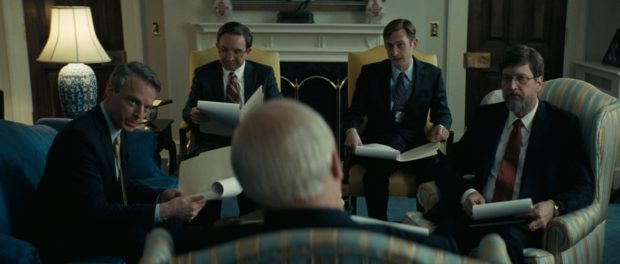Vice: The Politics of Dick Cheney
The new film Vice arrives on the big screen courtesy of writer/director Adam McKay. It brought together most of the same filmmaking team that dissected the 2005 U.S mortgage housing crisis and explored the inner workings of Wall Street in the 2015 Oscar nominated movie The Big Short. This time, the political career of former U.S. Vice President Dick Cheney is put under the microscope. To say that Christian Bale effectively portrays Dick Cheney isn’t giving the actor his due; it’s more a matter of Bale actually inhabiting this real life character. The rest of the cast isn’t bad either with supporting performances from a virtual “who’s who” of acting including Amy Adams (as Lynne Cheney), Steve Carell (Donald Rumsfeld), Sam Rockwell (George W. Bush), and Tyler Perry (Colin Powell).
During a time when we’re constantly being bombarded by stories detailing the continuing follies and foibles of Trump’s White House, it seems as if the line between politics and entertainment has never been more blurry. George W. Bush, like Donald Trump, was a polarizing figure. Vice not only gives audiences a behind the scenes glimpse into the inner workings of his presidency, but also provides us with an in-depth look at the shadowy figure who served as a guiding hand in shaping the policies of his administration, VP Dick Cheney. As a VP, Cheney is portrayed as refusing to accept the traditional and mostly symbolic role of second-in-command, opting instead to act as Bush’s puppet master. He ends up playing a powerful role in terms of shaping public policy and calling the shots in the US’s so-called “war on terror.”

Christian Bale, who won an Oscar in 2011 for his role in The Fighter, is known for taking on challenging roles and going to extremes in order to get into character. In the 2004 film The Machinist, the actor reportedly lost 63 pounds in preparation for his leading role. For Vice, Bale is said to have gained 45 pounds in order to more closely resemble his real life character. Apart from the physical transformation, however, Bale obviously did his research: the actor is able to successfully replicate everything from Cheney’s gait to his personal mannerisms and unique way of speaking.
One of the most interesting aspects of Vice is the innovative way in which the story is presented. Using cinematic devices such as a non-identified narrator, writer/director McKay is able to communicate an almost whimsical delight, not only in the material but more broadly in regards to film as a medium. At times McKay breaks down the fourth wall and lets viewers in on the joke, as in one humorous sequence in which Cheney and his wife suddenly break into Elizabethan English and engage in a discussion more suited to a Shakespearean tragedy than a modern theatrical movie.

Like The Big Short, the issues and politics explored in Vice are complex and multidimensional. Despite such lofty material, however, during no time do the filmmakers appear to talk down to its viewers; instead they seem to take the intelligence of the viewers as a given. Vice could be interpreted as a call to action, as it seems geared toward encouraging all who see it to ask questions, become informed, and get active in the political process. The end sequence, set in a research meeting, effectively drives home this point by drawing attention to two of the central problems plaguing modern politics: public apathy and a disconnect between the government and its citizens.
Vice is now playing in theatres.






